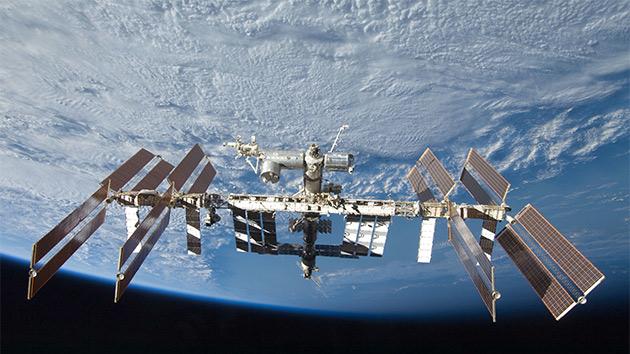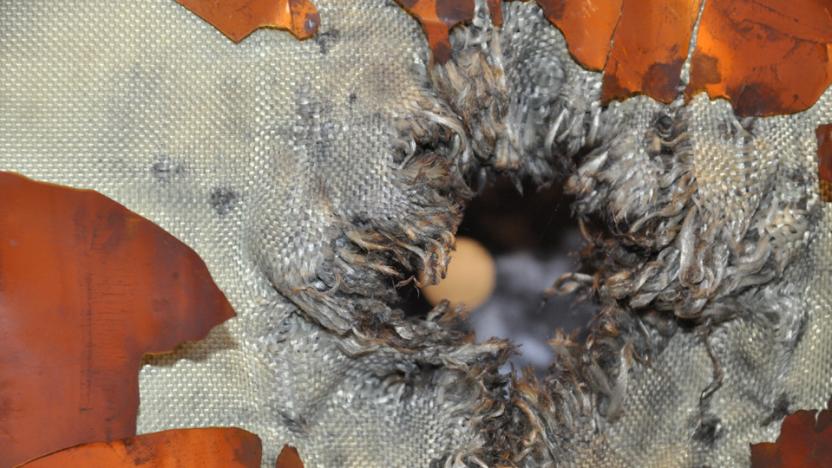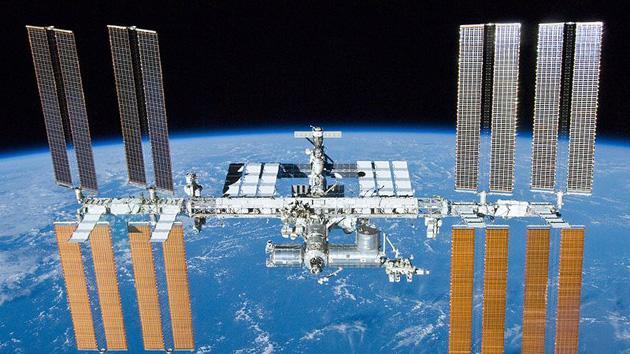internationalspacestation
Latest

The Big Picture: cooling molten metal in space
Ever wonder what hot metal would be like if it weren't bound by containers, liquids... or even gravity? You're looking at it. The European Space Agency has developed an electromagnetic levitator that the International Space Station is using to see how molten metal cools when it's free of the constraints you typically find on Earth. This experiment isn't intended solely as eye candy, of course. The station crew will use a high-speed camera to record the cooling process and make note of how it affects material structures. If the tests prove fruitful, they could teach people on the ground how to forge metal alloys with greater strength, exotic patterns and other traits that are very hard to produce using modern day techniques.

Europe's space agency is also sending a 3D printer to the ISS
The ISS will soon serve as home to not one, but two 3D printers, courtesy of the European Space Agency. It's a small cube that measures 10 inches on all sides, and it's slated to reach orbit in the first half of 2015 to coincide with Italian astronaut Samantha Cristoforetti's ISS expedition. The device, called Portable On-Board Printer or POP3D, was developed by Italy's ASI space agency to require very little power while creating objects through a heat-based process -- a technology different from what NASA's device uses. Aboard the ISS, it will be printing out biodegradable plastic components (it's unclear what those parts will be at this point), which will then be sent back to Earth for comparison against similar ones printed on the ground.

What you need to know about life on the International Space Station
In an unfortunate turn of events, Orbital Sciences' Antares rocket exploded a few seconds after launch last week. The rocket was thankfully unmanned, but it was intended to ferry critical supplies to astronauts and cosmonauts aboard the International Space Station. Luckily, crew members currently aboard the space station have enough food to last until March 2015 -- more than enough, as some are scheduled to come home this month. People living on the ISS depend on the ground crew for most of their needs, and each resupply mission brings spare parts and hardware needed for repairs and experiments, packaged food and hygiene supplies. These hygiene amenities and prepackaged chow differ quite a bit from what we typically use: The shampoo and hand soap, for instance, are the special no-rinse kind, while some of the food comes in dehydrated powder form. Want to hear more about life out there in zero-g? We do too, so we've dug deep into how astronauts and cosmonauts live each day in the ISS: from what kind of work they do to how they use the toilet.

Spaceborne whisky returns to Earth
Interested in finding out what whisky matured in space tastes like? You may get a chance sooner than you think. Scottish distillery Ardbeg teamed up with the scientists at NanoRacks to put vials of whisky aboard the International Space Station three years ago, and those vials recently returned to Earth. The two companies are now analyzing molecules from the otherworldly beverage to see if they interact with oak any differently than otherwise identical samples that stayed on the ground. You'll find out the effects of microgravity on your stiff drinks when the research finishes up in 2015. Space may not have any significant impact on the flavor, let alone a good one, but it's easy to imagine distilleries eventually boasting of how long their whisky has remained free from the planet's clutches.

The Big Picture: A massive typhoon as seen from orbit
No, a black hole didn't suddenly open up on the Earth's surface. That's Vongfong, a gigantic storm (then a super typhoon) that has been causing chaos in the Asia-Pacific region for much of October. NASA astronaut Reid Weisman posted this dramatic photo as the International Space Station orbited overhead on the morning of October 9th, when Vongfong was getting close to Okinawa. It had been downgraded to "just" a category 4 super typhoon by then, but that still made it both enormous and dangerous -- the eye alone was about 30 miles across, and it had sustained winds of nearly 150MPH. As beautiful as this orbital view may be, it's comforting to know that Vongfong has since weakened to a tropical storm and isn't posing nearly as much of a threat.

Almost all the sci-fi spaceships you know are on this massive chart
If you regularly follow geek culture, you've probably seen early versions of Dirk Loechel's spaceship comparison chart, which shows the relative sizes of vehicles from science fiction games, movies and TV shows. Well, it's finished -- and it's even more authoritative than the last time around. Get the full-size version and you'll see Babylon 5's Vorlon Planet Killer, Mass Effect's Normandy and seemingly everything in between. The chart even includes a real vessel, the International Space Station -- at 328 feet long, it seems downright puny next to its make-believe counterparts. Some story franchises have better representation than others (EVE is full of colossal ships), and you won't see moon-sized spacecraft like Star Wars' Death Star, but it's otherwise hard to imagine a more complete view of sci-fi transportation.

The first zero-g 3D printer is about to launch into orbit (update: launch scrubbed)
Gravity. More than the name of a killer movie, it's likely something we take for granted every single day. After all, nearly everything we do is reliant on the idea that stuff stays in place when we stop holding it. Astronauts don't have that luxury, however, and when even simple tasks take a ton of effort, something relatively complex like using a 3D printer is even harder. Why would astronauts need one of those? Well, because stuff breaks in space, and replacing a busted part isn't as simple as hitting Home Depot -- just ask the crew of Apollo 13. To help get around that, the folks at Made in Space have designed a 3D printer that circumvents the lack of Earth's gravity when used in orbit. Instead of molten filament essentially "stacking" on itself to form an object like it does planetside, according to The Verge, the Zero-G Printer liquid's surface-tension holds a widget together. Update: No launch tonight! Weather conditions forced a postponement. According to NASA, the next launch window is tomorrow night, on the 21st at about 1:52 AM ET.

Boeing and SpaceX will shuttle American astronauts to the ISS
There had been rumors of NASA awarding Boeing a big contract for its Commercial Crew Program, and it turns out that the claims were true -- and then some. The agency has just announced that both Boeing's CST-100 capsule and SpaceX's Dragon V2 will ferry American astronauts to the International Space Station from 2017 onward. Most of the funding ($4.2 billion) will go to Boeing's entry, but the SpaceX deal is still pretty hefty at $2.6 billion. Once both vehicles are certified and tested, they'll participate in manned scientific missions (up to six each) and serve as lifeboats in emergencies. Unfortunately, Sierra Nevada's aircraft-like Dream Chaser isn't part of the picture. It's ultimately a good day for space travel, but those hoping for a Space Shuttle-like design will be disappointed.

Russian official claims sea plankton was found clinging to ISS windows
There are plenty of places you'd expect to find plankton -- lakes, oceans, reruns of SpongeBob Squarepants -- but the external hull of the International Space Station probably wouldn't make your list. And yet, that's exactly where Russian cosmonauts claim to have found some, according to Russian news agency ITAR-TASS. As it happens, you may want to take that report with a grain of salt: We reached out to NASA for comment and spokesperson Dan Huot said the organization has received "zero official data" from Russia's Roscosmos space agency to corroborate these claims. Looks like it'll be a while before we actually get to the bottom of this.

The Big Picture: Gaza conflict as seen from space
Earth's view from the International Space Station always makes for interesting imagery, and the latest to come from up there is no exception. Recently shared by European Space Agency astronaut Alexander Gerst, a telling picture shows what Gaza and Israel looked like as the ISS traveled over the troubled region. Gerst wrote in a blog post that, although he could see "explosions occur several times" while this was being snapped, the photo doesn't actually depict any blasts. Originally, previous reports suggested it did, but as PetaPixel pointed out, something like that would be extremely difficult "to capture effectively from space." Either way, Gerst described it as his "saddest photo yet."

Google Project Tango smartphones heading to space this week
Google is no stranger to having some of its devices up in space, what with the Nexus S and One each taking on different missions in years past. Up next: Project Tango. The search giant's smartphone, which packs 3D sensors that allow it to track and map just about anything around it, has been playing a role in NASA's Synchronized Position Hold, Engage, Reorient, Experimental Satellite program, otherwise known as SPHERES. As Reuters notes, these spherical satellites could one day "take over daily chores for astronauts or even handle risky duties outside of the vessel." Accordingly, on July 11th, NASA and Google are doing good on the promise to launch Project Tango smartphones into orbit, where they will be used as "the brains and eyes" of the bowling ball-sized, hovering robots at the International Space Station.

The Big Picture: Punching a hole in a (simulated) spacecraft
Space debris is a scary thing -- tiny objects become missiles that can destroy whole spacecraft. If you need proof, just take a look at the results of the European Space Agency's shield testing for its freighter, the Automated Transfer Vehicle (ATV). That gaping hole you see above is the result of shooting the ship's multi-layer Kevlar-Nextel fabric armor with an aluminum bullet traveling at 15,658MPH, a speed that's entirely possible for debris caught in orbit. The good news? As bad as this looks, the test was a resounding success; while the bullet tore through the shielding, it only scorched the aluminum wall underneath. When the last ATV visits the International Space Station this summer, astronauts won't have to worry that shrapnel from an ex-satellite will destroy their vital supplies. [Image credit: ESA-Stijn Laagland]

3D printer headed to the International Space Station this August
Astronauts on the International Space Station will need to make room for one more gadget: a NASA-certified 3D printer. The device, designed by Made in Space at NASA's Ames Research Park in Mountain View, will launch on SpaceX CRS-4 in August, a few months ahead of schedule. Initially, astronauts will test the printer in the ISS' microgravity environment, but eventually it could be used to build tools and other hardware needed for on-board repairs or cubesat deployments. Down the road, Made in Space's clients could also have access to the printer for their own experiments. "This is unprecedented access to space," CEO Aaron Kemmer said in a press release. "If you want to 3D print in space, contact us now." [Image credit: NASA]

Robot fixes robot on the ISS so astronauts don't have to (video)
When something goes wrong with the ISS, astronauts usually don their suits and brave the harsh conditions of space to do what needs to be done. But the space station's Canadian robotic arm (aptly called Canadarm2) is currently attempting to fix itself with minimal human input, thanks to its very special passenger -- a multi-limbed helper robot called Dextre. Canadarm2 carries the handymanrobot around to fix anything that's broken on the ISS or to catch unmanned vehicles headed for the station, such as SpaceX's Dragon capsule. This time, though, Canada's Space Agency is remotely controlling Dextre to move and replace old cameras on Canadarm2 itself.

America's next fleet of spaceships will have to double as lifeboats
Right now, there are six people living and working in the International Space Station as it hurtles around our little oasis among the stars. That thought alone is astonishing/freaky enough until you realize the sheer number of things that could go wrong (Gravity, anyone?). That's why it's no surprise that NASA wants the new ships that'll ferry people and supplies to the ISS to act as lifeboats in case things up there take a turn for the worse.

You can see the International Space Station's view of Earth right now
It's possible to see the International Space Station floating overhead if you have the right equipment and good timing, but have you ever wondered what it sees at any given moment? As of now, you won't have to. NASA has switched on the High Definition Earth Viewing (HDEV) experiment, an internet stream that shows the station's view of our planet in real time; you can check it out below. Developed and run in part by high school students, it includes both multiple 720p camera feeds and the ISS crew's radio chatter.

Build your own space station with LittleBits' NASA-approved kit
Many kids want to become astronauts, but getting them to embrace day-to-day space science is tougher -- it's not as exciting as setting foot on Mars. NASA is all too aware of this challenge, so it has teamed up with LittleBits to create the Space Kit, a build-it-yourself bundle that should make these routine experiments a little more exciting. The pack includes parts and lessons that teach junior Neil Armstrongs and Sally Rides about atmospheric readings, light waves and other aspects of NASA's work without requiring engineering or programming skills. Young ones can even build tiny vehicles of their own, including the International Space Station, a satellite and a planetary rover. The $189 kit won't necessarily lead to a career among the stars, but it could be a good way to spark some curiosity.

Watch Google test its 3D-sensing phones on robots in zero gravity
Wonder what Google's Project Tango-equipped SPHERES robots will look like when they're in action aboard the International Space Station? The company is more than happy to show you. It has posted video of a recent test that took the machines on a zero gravity simulation flight to see how the 3D environment sensors and other systems will work in practice. As you'll see in the clip, it wasn't quite as easy as testing on the ground -- Google's ATAP team had to work during brief bursts of weightlessness that could challenge both the employees and the devices.

White House agrees to fund International Space Station until 2024
The International Space Station just got another lease on life. The White House has approved funding that would keep the floating lab running until "at least" 2024, as long as other countries also chip in. The additional funding should help both general science research as well as the human endurance studies that NASA needs for voyages to asteroids and Mars. The extension is primarily good news for those who want a long-term human presence in space; it's the second extension past the original 2015 decommissioning timeframe. It's also potentially good for business, as the deal will give SpaceX and other private spaceflight companies a better chance at growing their fledgling operations. [Image credit: NASA]

NASA shows off Robonaut's gigantic new legs ahead of 2014 upgrade (video)
NASA's Robonaut assistant is about to get its biggest upgrade yet... and we do mean big. As part of a preview at ABC News, the space agency has revealed what its robot will look like when it gets legs in early 2014. Simply put, it's massive -- at eight feet tall and roughly 500 pounds, the mobilized machine will dwarf all of its human teammates. However, there's good reasons for the extra-large limbs. Astronaut Cady Coleman says that they'll let Robonaut climb swiftly through hatches on the International Space Station, giving it the stride of an "antelope" rather than making it take dainty steps. The improved automaton will have to learn how to move before it's ready to help its organic counterparts, but it could soon save ISS crew members from risky (or simply mundane) tasks.





